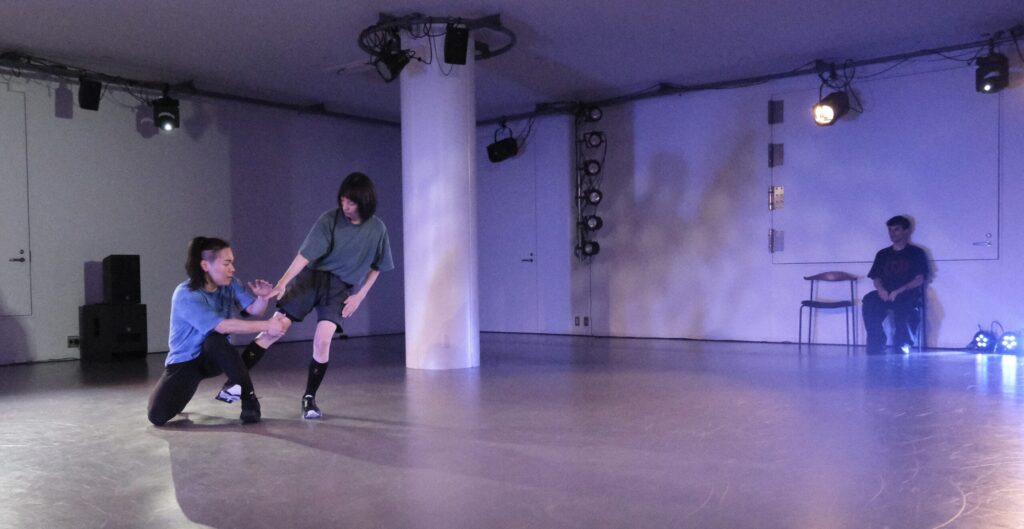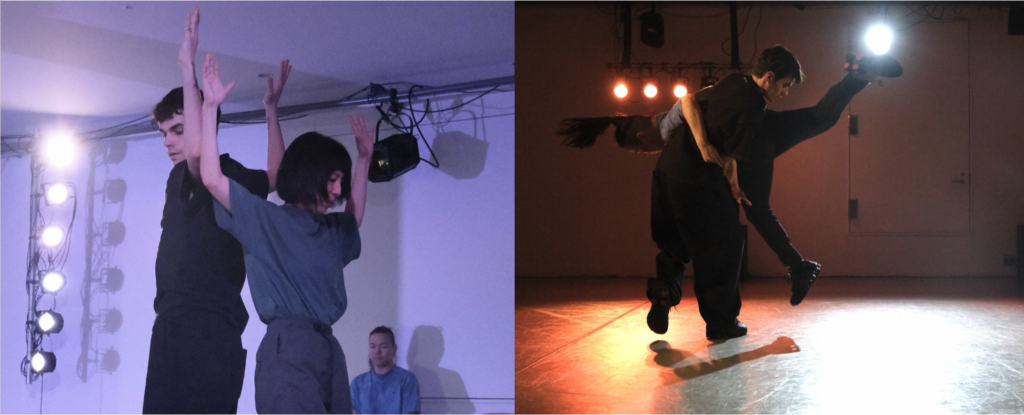Ayaka Ono, Yo Nakazawa, Space Not Blank Dance Work No. 1: Claude Debussy, “Exercises

Dance Work No. 1: Claude Debussy, Practice, Part 1|Work in Progress, January 2025, Dance Base Yokohama
Dance Work No. 1: Claude Debussy’s “Practice,” for which an open rehearsal/showing (work-in-progress) + artist talk was held in January 2025, is said to be the “first ‘dance work'” by Ayaka Ono, Yo Nakazawa, and Space Not Blank (hereinafter “Speno”). Needless to say, however, Speno is a collective that has been continuously working on dance and performing it. If “No. 1” is the first dance work, it would mean that the dances Speno has performed up to this point have not been works. Therefore, we would like to begin by confirming what Speno’s past efforts in dance have been.
The PERFORMANCES page of Speno’s Web site contains information on past performances. Surprisingly few of the three categories of performance, theater, and dance are labeled “dance,” and as of March 2025, there are only four: “Dance Work No. 1,” “Dance Work No. 2,” “Dance Work No. 3,” and “Physical Catharsis. What, then, is “Physical Catharsis,” the only one of Speno’s dances not labeled a “work”? According to Speno’s own explanation, it is “something that we have been researching, developing, and performing since 2019 as Space Knot Blank’s own method of generating movement,” and that it “has aspects of both a ‘method’ and a ‘work’ of dance” and “has characteristics of both process and result. It “has both aspects of a ‘method’ and a ‘work’ of dance” and “has the nature of both process and result. It is also described as “a unique mechanism for the generation of movement, which is a dance before dance works. In addition, the website’s “Physical Catharsis” page actually lists several performances of “Balance,” “Cycle,” “Street,” etc., in addition to the ones performed under the title of “Physical Catharsis. In other words, the information about Speno’s dance before “the work” is also listed. In other words, all of Speno’s efforts in dance prior to the “Work” were summed up under the name of “Physical Catharsis.
Let me draw another auxiliary line. Speno’s seemingly mysterious equation “process = result” is in fact a principle common to almost all performing arts. Or, it may be said to be the truth of the world. This is because the present is the accumulation of past efforts made during rehearsals. The present, the result of a performance, contains the past, the process that led to it. Speno often presents this commonplace, but therefore unacknowledged, principle/truth again at the site of performance. For example, in a theatrical work such as “The Color of Green,” the actors talk about the process (or something like it) leading up to the present of the performance, as if to say that the stage (art) is nothing but a place driven by the principle of “process=result” after all. In this way, the present is reduced to the accumulation of the past.
This principle of “process = result” can also be found in the practice of Physical Catharsis. Form,” one of the phases of “Physical Catharsis,” is a method of creating movement through a series of exchanges in which one person performs a short gesture and the next person performs a new short gesture in response (which Speno describes as “taking form”). This is a method that can be called “shiritori” (gesture shiritori), in which each individual’s short gesture is used to create a movement. Each short gesture in the form is the result of a series of exchanges leading up to it, and at the same time, it is a process leading up to the movement that is eventually created as a result of these exchanges. On the other hand, the movement as a series of gestures that is born as a result of such shiritori is a reproduction of the process that led to the movement.
The principle of “process = result” can be found as a common thread throughout Speno’s diverse and vast activities, but what can we make of his efforts in “No. 1” based on this principle? Intuitively, I would like to say that this piece was much more like a work of art than the previous performances of “Physical Catharsis”. The music, the lighting, the dance, and the dance all seemed to work together as a single unit (conversely, at least for me, the “Physical Catharsis” performances I have seen so far have not looked like that).
For example, six of the first 12 “exercises” were used in their entirety in this performance, and at the end of the first piece, “For Five Fingers,” there was a so-called “sound frame” sequence in which the dancers moved in sync with three chords being struck. Gauthier Asensi and Shizuka Yamaguchi jumped on the first chord, landed on the second, and paused with their hands raised on the third. Or, in the duo sequence of Gautier and Yusuke Miya in the third piece, “For the Fourth Degree,” there was an atmosphere that could be called erotic, as if in response to the tune of the piece. This may be due to the qualities of the dancers (in Speno’s creations, movements are basically created through the collaboration of the performers, so the qualities of the individual performers will inevitably affect the overall texture), but in any case, this is an extremely rare occurrence in Speno’s dances. In any case, this is extremely rare in Speno’s dances. The lighting (by Kakurauchi Komi) also dramatically illuminated the stage surface in accordance with the music. As far as I know, music and lighting have never been used in such a way in previous performances of “Physical Catharsis”. If “No. 1” seemed like a work of art, it was first and foremost due to the framing effect of the music and lighting.
 Dance Work No. 1: Claude Debussy, Practice, Part 1|Work in Progress, January 2025, Dance Base Yokohama
Dance Work No. 1: Claude Debussy, Practice, Part 1|Work in Progress, January 2025, Dance Base Yokohama
In fact, in the post-showing talk, there was a statement to the effect that some of the choreography was created in accordance with the music, and there is no doubt that the music in “No. 1” served to some extent as a frame to define the choreography. On the other hand, however, the majority (?) of the movement is still “physical” as before. On the other hand, it seems that the majority (?) of the movements were created using “physical catharsis” as a method, and in this sense, “No. 1” is certainly an extension of Speno’s previous approaches to dance. One very ordinary conclusion is that “Dance Work No. 1” is the result of Speno, who has been refining the method of “physical catharsis,” and has now fully committed himself to creating a dance work using it.
But is that really all there is to it? Speno says that he chose “Practice” as the music for “No. 1” because it is both a work and a practice piece (which he thought was interesting). Here again, the principle of “process = result” is on display. Then, is “No. 1” also a new phase of “physical catharsis,” which we might call a “frame,” for example, to explore methods to make a dance into a dance work? No, considering Speno’s professed resistance to “making a dance into a dance work,” it may even be more a way to open the unit of “work,” generally regarded as an outcome, into a process. The numbering of “dance works” may indicate that they are already part of a process. But in any case, despite their titles, the series of “dance works” have never been performed as completed works as of January 2025. No. 1″ and “No. 2” have only been performed as a showing/work-in-progress, and “No. 3” has only been announced for a premiere in October 2025. In this sense, the series of “dance works” are literally still in process. What will emerge when they are presented as “results”?
March 20, 2025
Kenta Yamazaki
▶︎ Dance Work No.3| Ayaka Ono, Yo Nakazawa, Space Not Blank


